Organisational Behaviour Report: Leadership Styles and Theories
VerifiedAdded on 2020/01/07
|13
|4107
|349
Report
AI Summary
This report delves into the realm of organisational behaviour, exploring various aspects such as organisational structure and culture, and their interrelation. It examines the impact of these factors on individual behaviour within the workplace, including demographic influences, leadership styles, and communication. The report further compares leadership styles across different organisations, contrasting autocratic, transformational, participative, and laissez-faire approaches. It then analyses organisational theories, including scientific management, human relations, and contingency approaches, as applied by companies like City Group Plc. and Enterprise Rent-A-Car. The study also evaluates the impact of different leadership styles on employee morale, productivity, and decision-making. Furthermore, the report explores motivational theories, such as Maslow's hierarchy of needs and equity theory, and their application within organisations. Finally, the report touches on group behaviour, team building factors, and the use of technology in business organisations.

Organisations and
Behaviour
Behaviour
Paraphrase This Document
Need a fresh take? Get an instant paraphrase of this document with our AI Paraphraser
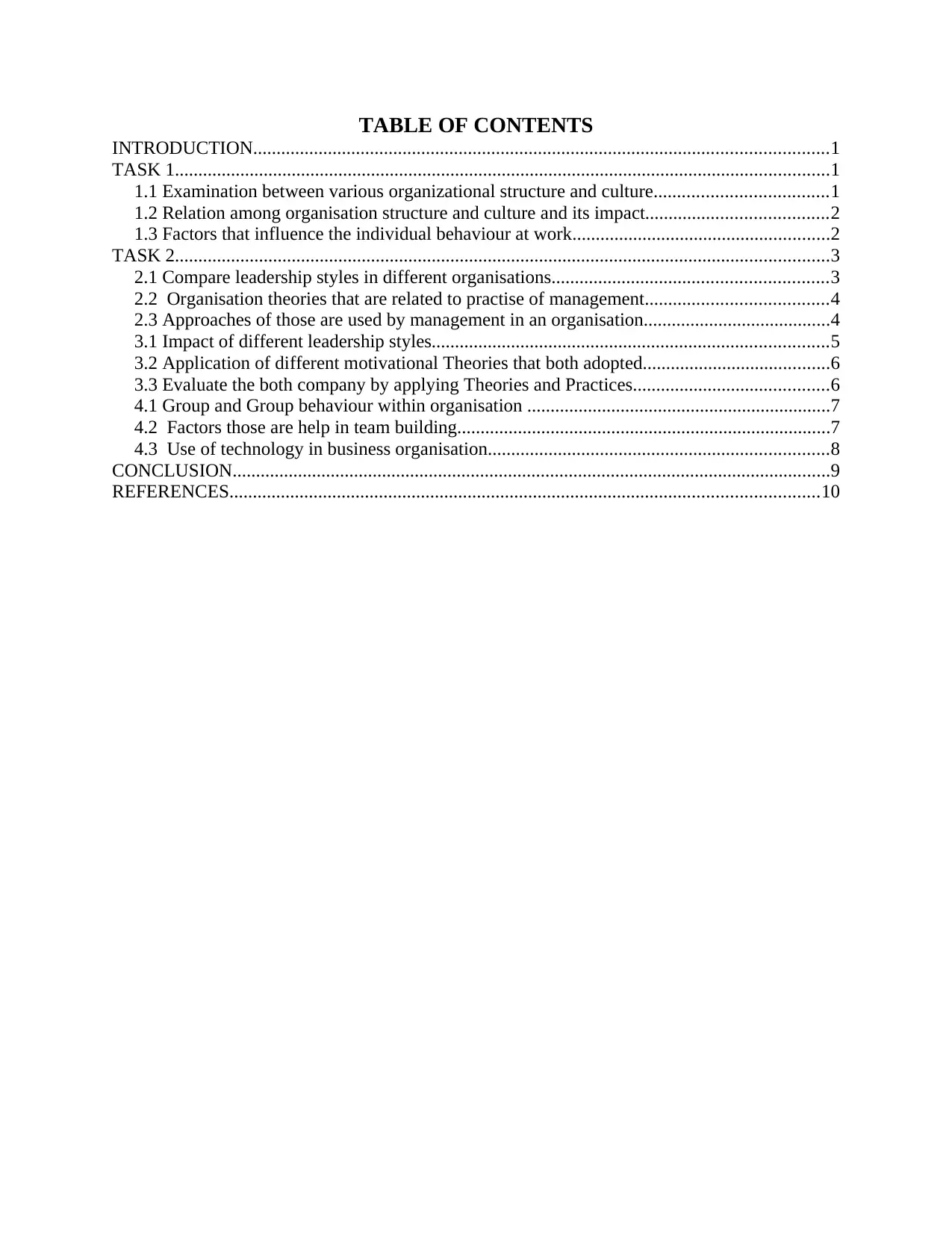
TABLE OF CONTENTS
INTRODUCTION...........................................................................................................................1
TASK 1............................................................................................................................................1
1.1 Examination between various organizational structure and culture.....................................1
1.2 Relation among organisation structure and culture and its impact.......................................2
1.3 Factors that influence the individual behaviour at work.......................................................2
TASK 2............................................................................................................................................3
2.1 Compare leadership styles in different organisations...........................................................3
2.2 Organisation theories that are related to practise of management.......................................4
2.3 Approaches of those are used by management in an organisation........................................4
3.1 Impact of different leadership styles.....................................................................................5
3.2 Application of different motivational Theories that both adopted........................................6
3.3 Evaluate the both company by applying Theories and Practices..........................................6
4.1 Group and Group behaviour within organisation .................................................................7
4.2 Factors those are help in team building................................................................................7
4.3 Use of technology in business organisation.........................................................................8
CONCLUSION................................................................................................................................9
REFERENCES..............................................................................................................................10
INTRODUCTION...........................................................................................................................1
TASK 1............................................................................................................................................1
1.1 Examination between various organizational structure and culture.....................................1
1.2 Relation among organisation structure and culture and its impact.......................................2
1.3 Factors that influence the individual behaviour at work.......................................................2
TASK 2............................................................................................................................................3
2.1 Compare leadership styles in different organisations...........................................................3
2.2 Organisation theories that are related to practise of management.......................................4
2.3 Approaches of those are used by management in an organisation........................................4
3.1 Impact of different leadership styles.....................................................................................5
3.2 Application of different motivational Theories that both adopted........................................6
3.3 Evaluate the both company by applying Theories and Practices..........................................6
4.1 Group and Group behaviour within organisation .................................................................7
4.2 Factors those are help in team building................................................................................7
4.3 Use of technology in business organisation.........................................................................8
CONCLUSION................................................................................................................................9
REFERENCES..............................................................................................................................10
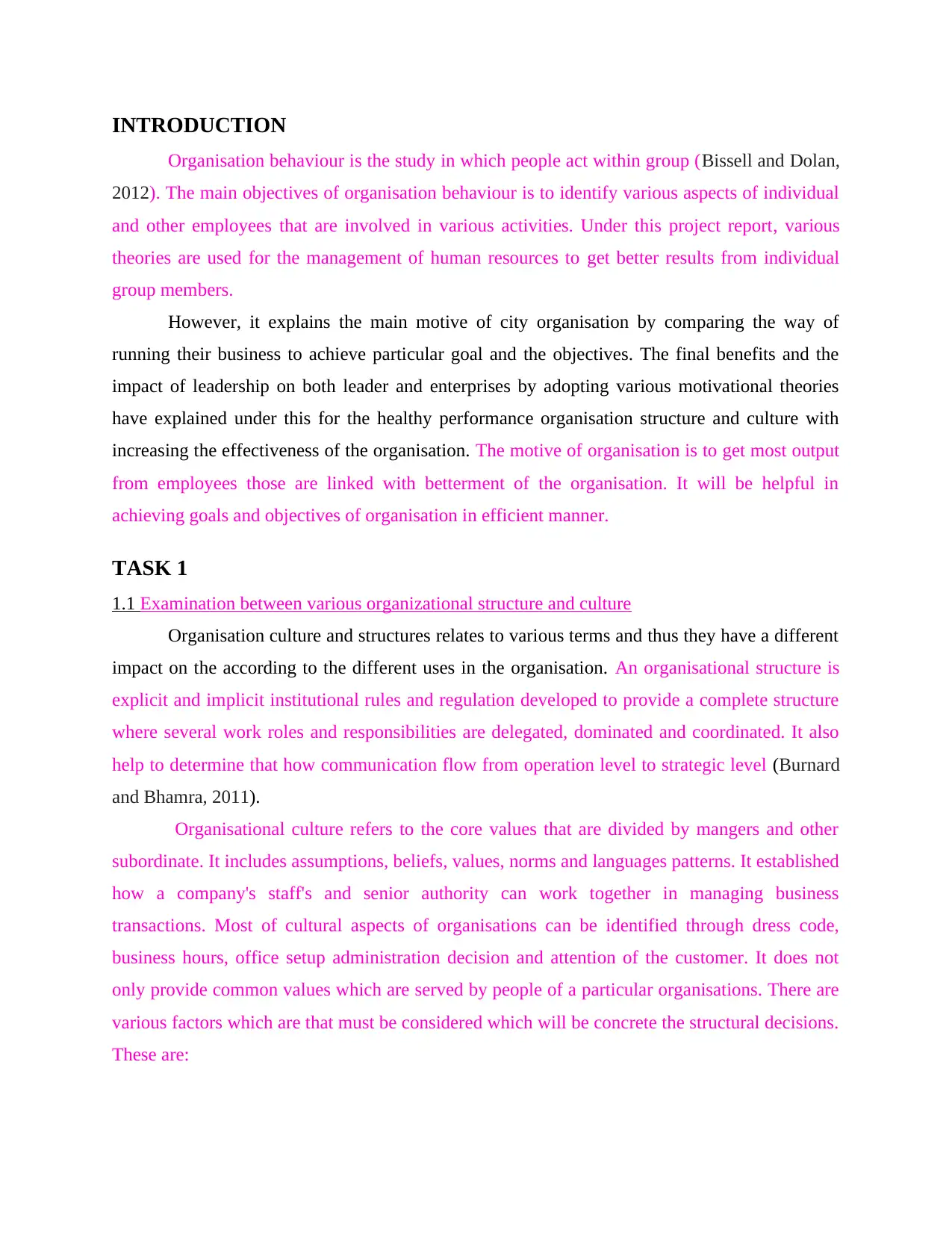
INTRODUCTION
Organisation behaviour is the study in which people act within group (Bissell and Dolan,
2012). The main objectives of organisation behaviour is to identify various aspects of individual
and other employees that are involved in various activities. Under this project report, various
theories are used for the management of human resources to get better results from individual
group members.
However, it explains the main motive of city organisation by comparing the way of
running their business to achieve particular goal and the objectives. The final benefits and the
impact of leadership on both leader and enterprises by adopting various motivational theories
have explained under this for the healthy performance organisation structure and culture with
increasing the effectiveness of the organisation. The motive of organisation is to get most output
from employees those are linked with betterment of the organisation. It will be helpful in
achieving goals and objectives of organisation in efficient manner.
TASK 1
1.1 Examination between various organizational structure and culture
Organisation culture and structures relates to various terms and thus they have a different
impact on the according to the different uses in the organisation. An organisational structure is
explicit and implicit institutional rules and regulation developed to provide a complete structure
where several work roles and responsibilities are delegated, dominated and coordinated. It also
help to determine that how communication flow from operation level to strategic level (Burnard
and Bhamra, 2011).
Organisational culture refers to the core values that are divided by mangers and other
subordinate. It includes assumptions, beliefs, values, norms and languages patterns. It established
how a company's staff's and senior authority can work together in managing business
transactions. Most of cultural aspects of organisations can be identified through dress code,
business hours, office setup administration decision and attention of the customer. It does not
only provide common values which are served by people of a particular organisations. There are
various factors which are that must be considered which will be concrete the structural decisions.
These are:
Organisation behaviour is the study in which people act within group (Bissell and Dolan,
2012). The main objectives of organisation behaviour is to identify various aspects of individual
and other employees that are involved in various activities. Under this project report, various
theories are used for the management of human resources to get better results from individual
group members.
However, it explains the main motive of city organisation by comparing the way of
running their business to achieve particular goal and the objectives. The final benefits and the
impact of leadership on both leader and enterprises by adopting various motivational theories
have explained under this for the healthy performance organisation structure and culture with
increasing the effectiveness of the organisation. The motive of organisation is to get most output
from employees those are linked with betterment of the organisation. It will be helpful in
achieving goals and objectives of organisation in efficient manner.
TASK 1
1.1 Examination between various organizational structure and culture
Organisation culture and structures relates to various terms and thus they have a different
impact on the according to the different uses in the organisation. An organisational structure is
explicit and implicit institutional rules and regulation developed to provide a complete structure
where several work roles and responsibilities are delegated, dominated and coordinated. It also
help to determine that how communication flow from operation level to strategic level (Burnard
and Bhamra, 2011).
Organisational culture refers to the core values that are divided by mangers and other
subordinate. It includes assumptions, beliefs, values, norms and languages patterns. It established
how a company's staff's and senior authority can work together in managing business
transactions. Most of cultural aspects of organisations can be identified through dress code,
business hours, office setup administration decision and attention of the customer. It does not
only provide common values which are served by people of a particular organisations. There are
various factors which are that must be considered which will be concrete the structural decisions.
These are:
⊘ This is a preview!⊘
Do you want full access?
Subscribe today to unlock all pages.

Trusted by 1+ million students worldwide
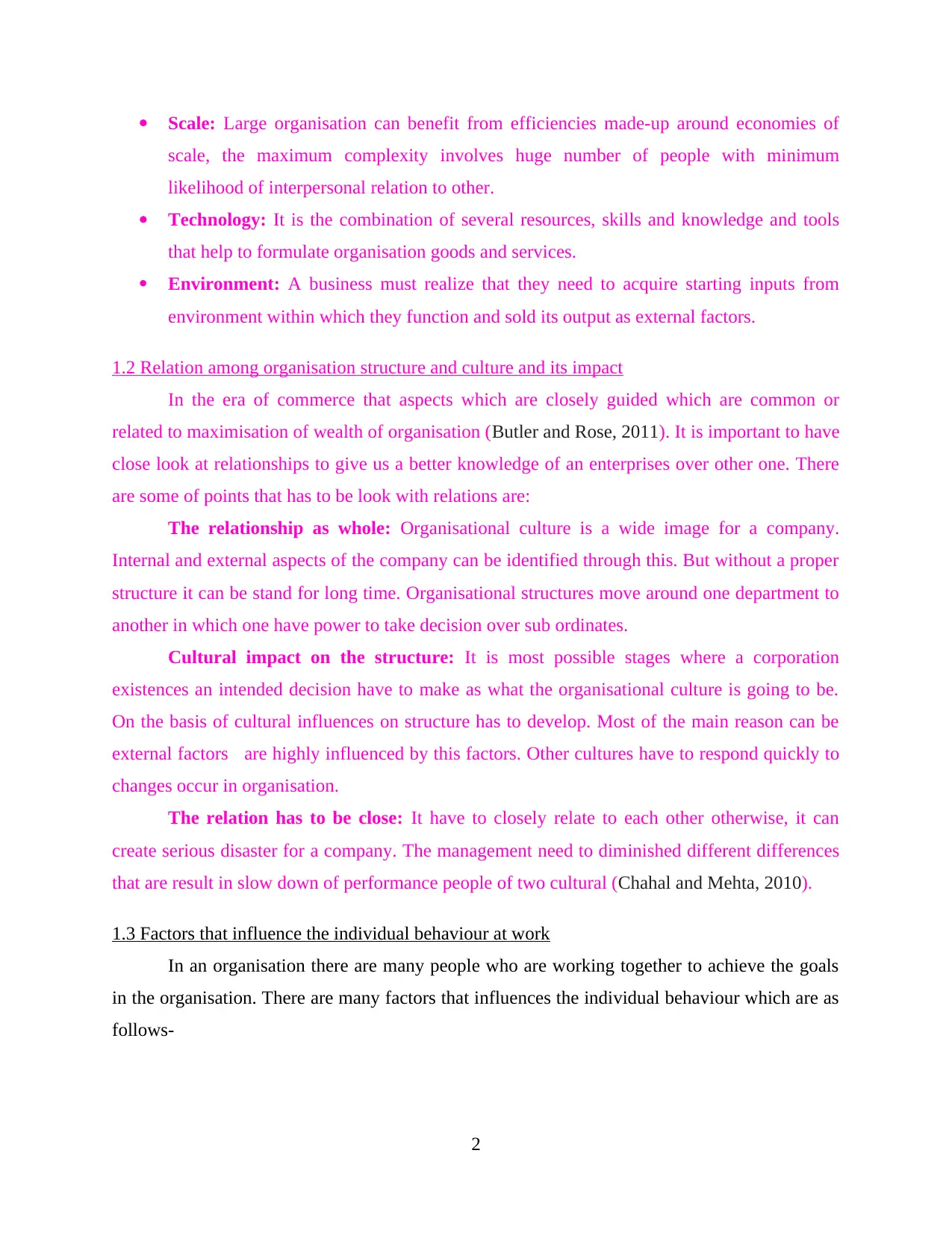
Scale: Large organisation can benefit from efficiencies made-up around economies of
scale, the maximum complexity involves huge number of people with minimum
likelihood of interpersonal relation to other.
Technology: It is the combination of several resources, skills and knowledge and tools
that help to formulate organisation goods and services.
Environment: A business must realize that they need to acquire starting inputs from
environment within which they function and sold its output as external factors.
1.2 Relation among organisation structure and culture and its impact
In the era of commerce that aspects which are closely guided which are common or
related to maximisation of wealth of organisation (Butler and Rose, 2011). It is important to have
close look at relationships to give us a better knowledge of an enterprises over other one. There
are some of points that has to be look with relations are:
The relationship as whole: Organisational culture is a wide image for a company.
Internal and external aspects of the company can be identified through this. But without a proper
structure it can be stand for long time. Organisational structures move around one department to
another in which one have power to take decision over sub ordinates.
Cultural impact on the structure: It is most possible stages where a corporation
existences an intended decision have to make as what the organisational culture is going to be.
On the basis of cultural influences on structure has to develop. Most of the main reason can be
external factors are highly influenced by this factors. Other cultures have to respond quickly to
changes occur in organisation.
The relation has to be close: It have to closely relate to each other otherwise, it can
create serious disaster for a company. The management need to diminished different differences
that are result in slow down of performance people of two cultural (Chahal and Mehta, 2010).
1.3 Factors that influence the individual behaviour at work
In an organisation there are many people who are working together to achieve the goals
in the organisation. There are many factors that influences the individual behaviour which are as
follows-
2
scale, the maximum complexity involves huge number of people with minimum
likelihood of interpersonal relation to other.
Technology: It is the combination of several resources, skills and knowledge and tools
that help to formulate organisation goods and services.
Environment: A business must realize that they need to acquire starting inputs from
environment within which they function and sold its output as external factors.
1.2 Relation among organisation structure and culture and its impact
In the era of commerce that aspects which are closely guided which are common or
related to maximisation of wealth of organisation (Butler and Rose, 2011). It is important to have
close look at relationships to give us a better knowledge of an enterprises over other one. There
are some of points that has to be look with relations are:
The relationship as whole: Organisational culture is a wide image for a company.
Internal and external aspects of the company can be identified through this. But without a proper
structure it can be stand for long time. Organisational structures move around one department to
another in which one have power to take decision over sub ordinates.
Cultural impact on the structure: It is most possible stages where a corporation
existences an intended decision have to make as what the organisational culture is going to be.
On the basis of cultural influences on structure has to develop. Most of the main reason can be
external factors are highly influenced by this factors. Other cultures have to respond quickly to
changes occur in organisation.
The relation has to be close: It have to closely relate to each other otherwise, it can
create serious disaster for a company. The management need to diminished different differences
that are result in slow down of performance people of two cultural (Chahal and Mehta, 2010).
1.3 Factors that influence the individual behaviour at work
In an organisation there are many people who are working together to achieve the goals
in the organisation. There are many factors that influences the individual behaviour which are as
follows-
2
Paraphrase This Document
Need a fresh take? Get an instant paraphrase of this document with our AI Paraphraser
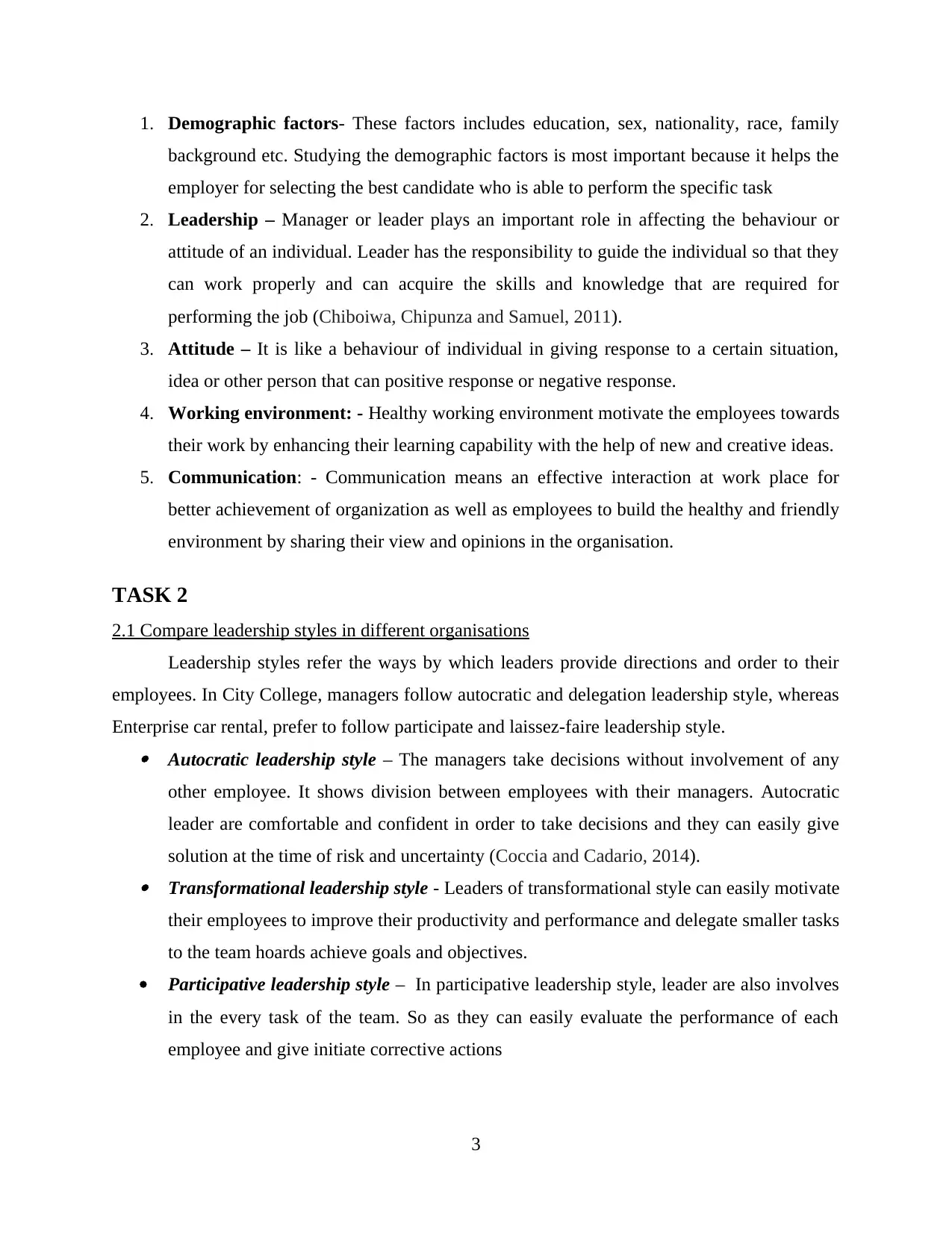
1. Demographic factors- These factors includes education, sex, nationality, race, family
background etc. Studying the demographic factors is most important because it helps the
employer for selecting the best candidate who is able to perform the specific task
2. Leadership – Manager or leader plays an important role in affecting the behaviour or
attitude of an individual. Leader has the responsibility to guide the individual so that they
can work properly and can acquire the skills and knowledge that are required for
performing the job (Chiboiwa, Chipunza and Samuel, 2011).
3. Attitude – It is like a behaviour of individual in giving response to a certain situation,
idea or other person that can positive response or negative response.
4. Working environment: - Healthy working environment motivate the employees towards
their work by enhancing their learning capability with the help of new and creative ideas.
5. Communication: - Communication means an effective interaction at work place for
better achievement of organization as well as employees to build the healthy and friendly
environment by sharing their view and opinions in the organisation.
TASK 2
2.1 Compare leadership styles in different organisations
Leadership styles refer the ways by which leaders provide directions and order to their
employees. In City College, managers follow autocratic and delegation leadership style, whereas
Enterprise car rental, prefer to follow participate and laissez-faire leadership style. Autocratic leadership style – The managers take decisions without involvement of any
other employee. It shows division between employees with their managers. Autocratic
leader are comfortable and confident in order to take decisions and they can easily give
solution at the time of risk and uncertainty (Coccia and Cadario, 2014). Transformational leadership style - Leaders of transformational style can easily motivate
their employees to improve their productivity and performance and delegate smaller tasks
to the team hoards achieve goals and objectives.
Participative leadership style – In participative leadership style, leader are also involves
in the every task of the team. So as they can easily evaluate the performance of each
employee and give initiate corrective actions
3
background etc. Studying the demographic factors is most important because it helps the
employer for selecting the best candidate who is able to perform the specific task
2. Leadership – Manager or leader plays an important role in affecting the behaviour or
attitude of an individual. Leader has the responsibility to guide the individual so that they
can work properly and can acquire the skills and knowledge that are required for
performing the job (Chiboiwa, Chipunza and Samuel, 2011).
3. Attitude – It is like a behaviour of individual in giving response to a certain situation,
idea or other person that can positive response or negative response.
4. Working environment: - Healthy working environment motivate the employees towards
their work by enhancing their learning capability with the help of new and creative ideas.
5. Communication: - Communication means an effective interaction at work place for
better achievement of organization as well as employees to build the healthy and friendly
environment by sharing their view and opinions in the organisation.
TASK 2
2.1 Compare leadership styles in different organisations
Leadership styles refer the ways by which leaders provide directions and order to their
employees. In City College, managers follow autocratic and delegation leadership style, whereas
Enterprise car rental, prefer to follow participate and laissez-faire leadership style. Autocratic leadership style – The managers take decisions without involvement of any
other employee. It shows division between employees with their managers. Autocratic
leader are comfortable and confident in order to take decisions and they can easily give
solution at the time of risk and uncertainty (Coccia and Cadario, 2014). Transformational leadership style - Leaders of transformational style can easily motivate
their employees to improve their productivity and performance and delegate smaller tasks
to the team hoards achieve goals and objectives.
Participative leadership style – In participative leadership style, leader are also involves
in the every task of the team. So as they can easily evaluate the performance of each
employee and give initiate corrective actions
3

Free rein style- Leader assigned the task to everyone and ask for completing the task
with in the specific time period. In this leaders don't take any decision and leave this
function on the employees (Dief and Font, 2010).
Transactional leadership style – Managers of Car rental seeks to follow transactional
leadership style in order to receive certain task to perform and give necessary punishment
or rewards to team members. So as with the fear to punishment the behaviour of the
employees can easily change.
2.2 Organisation theories that are related to practice of management
Organisational theory is the discipline that studies the structure and design of
organisations. In different areas of business theories are underpinned in most of the department
of management of any concern organisation. As the main objective of organisation is to achieve
the goals that are set by the organisation. It evaluate correct structure of organisations and offers
recommendation on how their potency can be solved. (Fuchs and Edwards, 2012). City Group
Plc. and Enterprise Rent-A-Car are using various theories those are: Scientific management,
classical administration, human relation approaches, system approach and contingency
approaches.
City group Plc. is using human relation approach theory to make use of human relations
in serving best customer relation by providing appropriate services to them. The important of this
theory is that manager need to understand the workers faith and their needs. Manager also need
to overcome less control over employees so that they can perform their task in efficient manner.
In order to make appropriate decision making styles and teamwork are adopted effectively by
employees in the organisation.
2.3 Approaches of those are used by management in an organisation
There are different approaches that are used by management in making appropriate
strategies for their organisations. Some of them are as follows that use by City Group Plc.-
1. Contingency approach – The management theories are associated with integrated plan.
Managers should realized that not only one theories that can be used for every different
situation. This approach help to evaluate potential solution that would create benefit of
taking into consideration to every threats that are linked to organisation.
4
with in the specific time period. In this leaders don't take any decision and leave this
function on the employees (Dief and Font, 2010).
Transactional leadership style – Managers of Car rental seeks to follow transactional
leadership style in order to receive certain task to perform and give necessary punishment
or rewards to team members. So as with the fear to punishment the behaviour of the
employees can easily change.
2.2 Organisation theories that are related to practice of management
Organisational theory is the discipline that studies the structure and design of
organisations. In different areas of business theories are underpinned in most of the department
of management of any concern organisation. As the main objective of organisation is to achieve
the goals that are set by the organisation. It evaluate correct structure of organisations and offers
recommendation on how their potency can be solved. (Fuchs and Edwards, 2012). City Group
Plc. and Enterprise Rent-A-Car are using various theories those are: Scientific management,
classical administration, human relation approaches, system approach and contingency
approaches.
City group Plc. is using human relation approach theory to make use of human relations
in serving best customer relation by providing appropriate services to them. The important of this
theory is that manager need to understand the workers faith and their needs. Manager also need
to overcome less control over employees so that they can perform their task in efficient manner.
In order to make appropriate decision making styles and teamwork are adopted effectively by
employees in the organisation.
2.3 Approaches of those are used by management in an organisation
There are different approaches that are used by management in making appropriate
strategies for their organisations. Some of them are as follows that use by City Group Plc.-
1. Contingency approach – The management theories are associated with integrated plan.
Managers should realized that not only one theories that can be used for every different
situation. This approach help to evaluate potential solution that would create benefit of
taking into consideration to every threats that are linked to organisation.
4
⊘ This is a preview!⊘
Do you want full access?
Subscribe today to unlock all pages.

Trusted by 1+ million students worldwide
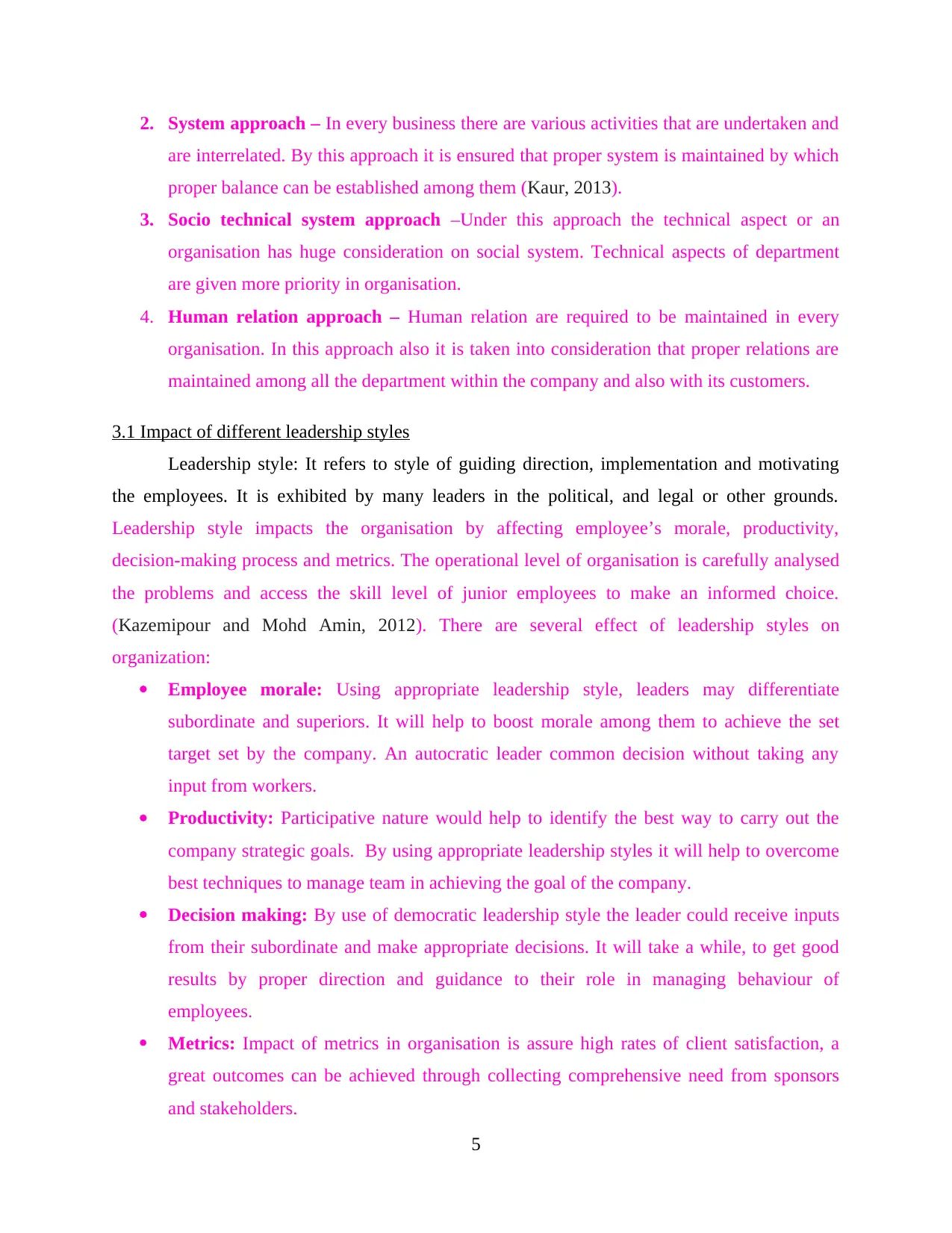
2. System approach – In every business there are various activities that are undertaken and
are interrelated. By this approach it is ensured that proper system is maintained by which
proper balance can be established among them (Kaur, 2013).
3. Socio technical system approach –Under this approach the technical aspect or an
organisation has huge consideration on social system. Technical aspects of department
are given more priority in organisation.
4. Human relation approach – Human relation are required to be maintained in every
organisation. In this approach also it is taken into consideration that proper relations are
maintained among all the department within the company and also with its customers.
3.1 Impact of different leadership styles
Leadership style: It refers to style of guiding direction, implementation and motivating
the employees. It is exhibited by many leaders in the political, and legal or other grounds.
Leadership style impacts the organisation by affecting employee’s morale, productivity,
decision-making process and metrics. The operational level of organisation is carefully analysed
the problems and access the skill level of junior employees to make an informed choice.
(Kazemipour and Mohd Amin, 2012). There are several effect of leadership styles on
organization:
Employee morale: Using appropriate leadership style, leaders may differentiate
subordinate and superiors. It will help to boost morale among them to achieve the set
target set by the company. An autocratic leader common decision without taking any
input from workers.
Productivity: Participative nature would help to identify the best way to carry out the
company strategic goals. By using appropriate leadership styles it will help to overcome
best techniques to manage team in achieving the goal of the company.
Decision making: By use of democratic leadership style the leader could receive inputs
from their subordinate and make appropriate decisions. It will take a while, to get good
results by proper direction and guidance to their role in managing behaviour of
employees.
Metrics: Impact of metrics in organisation is assure high rates of client satisfaction, a
great outcomes can be achieved through collecting comprehensive need from sponsors
and stakeholders.
5
are interrelated. By this approach it is ensured that proper system is maintained by which
proper balance can be established among them (Kaur, 2013).
3. Socio technical system approach –Under this approach the technical aspect or an
organisation has huge consideration on social system. Technical aspects of department
are given more priority in organisation.
4. Human relation approach – Human relation are required to be maintained in every
organisation. In this approach also it is taken into consideration that proper relations are
maintained among all the department within the company and also with its customers.
3.1 Impact of different leadership styles
Leadership style: It refers to style of guiding direction, implementation and motivating
the employees. It is exhibited by many leaders in the political, and legal or other grounds.
Leadership style impacts the organisation by affecting employee’s morale, productivity,
decision-making process and metrics. The operational level of organisation is carefully analysed
the problems and access the skill level of junior employees to make an informed choice.
(Kazemipour and Mohd Amin, 2012). There are several effect of leadership styles on
organization:
Employee morale: Using appropriate leadership style, leaders may differentiate
subordinate and superiors. It will help to boost morale among them to achieve the set
target set by the company. An autocratic leader common decision without taking any
input from workers.
Productivity: Participative nature would help to identify the best way to carry out the
company strategic goals. By using appropriate leadership styles it will help to overcome
best techniques to manage team in achieving the goal of the company.
Decision making: By use of democratic leadership style the leader could receive inputs
from their subordinate and make appropriate decisions. It will take a while, to get good
results by proper direction and guidance to their role in managing behaviour of
employees.
Metrics: Impact of metrics in organisation is assure high rates of client satisfaction, a
great outcomes can be achieved through collecting comprehensive need from sponsors
and stakeholders.
5
Paraphrase This Document
Need a fresh take? Get an instant paraphrase of this document with our AI Paraphraser
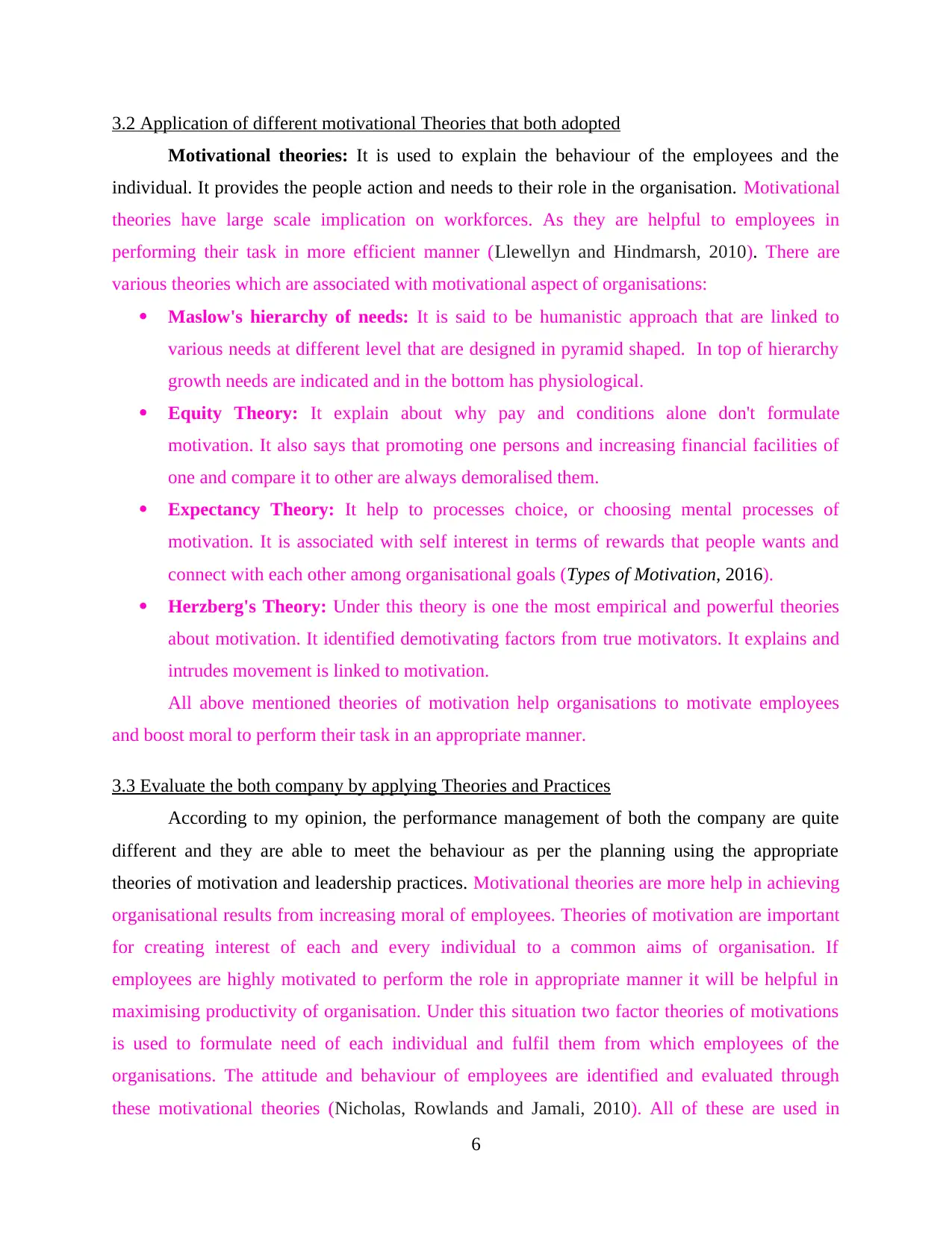
3.2 Application of different motivational Theories that both adopted
Motivational theories: It is used to explain the behaviour of the employees and the
individual. It provides the people action and needs to their role in the organisation. Motivational
theories have large scale implication on workforces. As they are helpful to employees in
performing their task in more efficient manner (Llewellyn and Hindmarsh, 2010). There are
various theories which are associated with motivational aspect of organisations:
Maslow's hierarchy of needs: It is said to be humanistic approach that are linked to
various needs at different level that are designed in pyramid shaped. In top of hierarchy
growth needs are indicated and in the bottom has physiological.
Equity Theory: It explain about why pay and conditions alone don't formulate
motivation. It also says that promoting one persons and increasing financial facilities of
one and compare it to other are always demoralised them.
Expectancy Theory: It help to processes choice, or choosing mental processes of
motivation. It is associated with self interest in terms of rewards that people wants and
connect with each other among organisational goals (Types of Motivation, 2016).
Herzberg's Theory: Under this theory is one the most empirical and powerful theories
about motivation. It identified demotivating factors from true motivators. It explains and
intrudes movement is linked to motivation.
All above mentioned theories of motivation help organisations to motivate employees
and boost moral to perform their task in an appropriate manner.
3.3 Evaluate the both company by applying Theories and Practices
According to my opinion, the performance management of both the company are quite
different and they are able to meet the behaviour as per the planning using the appropriate
theories of motivation and leadership practices. Motivational theories are more help in achieving
organisational results from increasing moral of employees. Theories of motivation are important
for creating interest of each and every individual to a common aims of organisation. If
employees are highly motivated to perform the role in appropriate manner it will be helpful in
maximising productivity of organisation. Under this situation two factor theories of motivations
is used to formulate need of each individual and fulfil them from which employees of the
organisations. The attitude and behaviour of employees are identified and evaluated through
these motivational theories (Nicholas, Rowlands and Jamali, 2010). All of these are used in
6
Motivational theories: It is used to explain the behaviour of the employees and the
individual. It provides the people action and needs to their role in the organisation. Motivational
theories have large scale implication on workforces. As they are helpful to employees in
performing their task in more efficient manner (Llewellyn and Hindmarsh, 2010). There are
various theories which are associated with motivational aspect of organisations:
Maslow's hierarchy of needs: It is said to be humanistic approach that are linked to
various needs at different level that are designed in pyramid shaped. In top of hierarchy
growth needs are indicated and in the bottom has physiological.
Equity Theory: It explain about why pay and conditions alone don't formulate
motivation. It also says that promoting one persons and increasing financial facilities of
one and compare it to other are always demoralised them.
Expectancy Theory: It help to processes choice, or choosing mental processes of
motivation. It is associated with self interest in terms of rewards that people wants and
connect with each other among organisational goals (Types of Motivation, 2016).
Herzberg's Theory: Under this theory is one the most empirical and powerful theories
about motivation. It identified demotivating factors from true motivators. It explains and
intrudes movement is linked to motivation.
All above mentioned theories of motivation help organisations to motivate employees
and boost moral to perform their task in an appropriate manner.
3.3 Evaluate the both company by applying Theories and Practices
According to my opinion, the performance management of both the company are quite
different and they are able to meet the behaviour as per the planning using the appropriate
theories of motivation and leadership practices. Motivational theories are more help in achieving
organisational results from increasing moral of employees. Theories of motivation are important
for creating interest of each and every individual to a common aims of organisation. If
employees are highly motivated to perform the role in appropriate manner it will be helpful in
maximising productivity of organisation. Under this situation two factor theories of motivations
is used to formulate need of each individual and fulfil them from which employees of the
organisations. The attitude and behaviour of employees are identified and evaluated through
these motivational theories (Nicholas, Rowlands and Jamali, 2010). All of these are used in
6
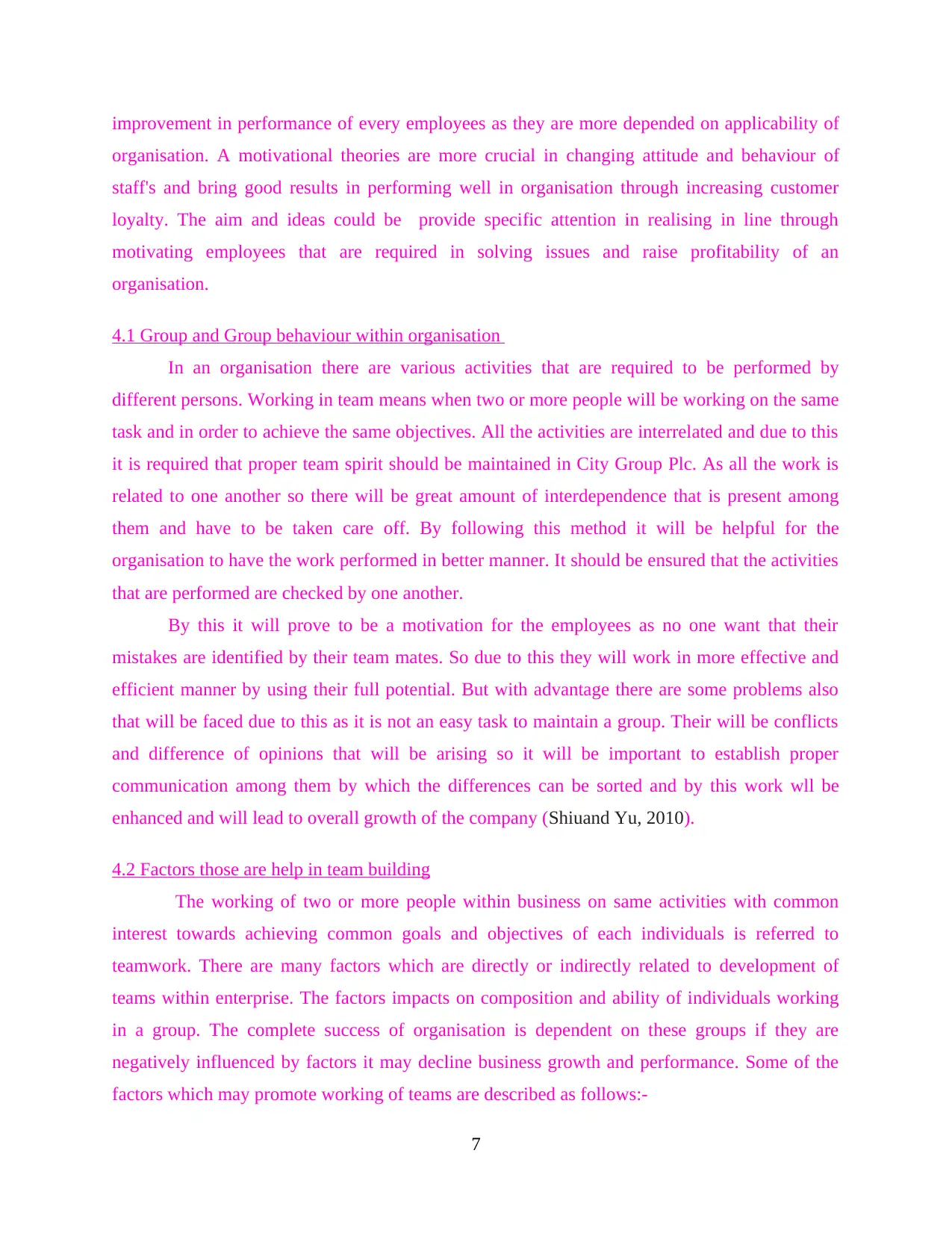
improvement in performance of every employees as they are more depended on applicability of
organisation. A motivational theories are more crucial in changing attitude and behaviour of
staff's and bring good results in performing well in organisation through increasing customer
loyalty. The aim and ideas could be provide specific attention in realising in line through
motivating employees that are required in solving issues and raise profitability of an
organisation.
4.1 Group and Group behaviour within organisation
In an organisation there are various activities that are required to be performed by
different persons. Working in team means when two or more people will be working on the same
task and in order to achieve the same objectives. All the activities are interrelated and due to this
it is required that proper team spirit should be maintained in City Group Plc. As all the work is
related to one another so there will be great amount of interdependence that is present among
them and have to be taken care off. By following this method it will be helpful for the
organisation to have the work performed in better manner. It should be ensured that the activities
that are performed are checked by one another.
By this it will prove to be a motivation for the employees as no one want that their
mistakes are identified by their team mates. So due to this they will work in more effective and
efficient manner by using their full potential. But with advantage there are some problems also
that will be faced due to this as it is not an easy task to maintain a group. Their will be conflicts
and difference of opinions that will be arising so it will be important to establish proper
communication among them by which the differences can be sorted and by this work wll be
enhanced and will lead to overall growth of the company (Shiuand Yu, 2010).
4.2 Factors those are help in team building
The working of two or more people within business on same activities with common
interest towards achieving common goals and objectives of each individuals is referred to
teamwork. There are many factors which are directly or indirectly related to development of
teams within enterprise. The factors impacts on composition and ability of individuals working
in a group. The complete success of organisation is dependent on these groups if they are
negatively influenced by factors it may decline business growth and performance. Some of the
factors which may promote working of teams are described as follows:-
7
organisation. A motivational theories are more crucial in changing attitude and behaviour of
staff's and bring good results in performing well in organisation through increasing customer
loyalty. The aim and ideas could be provide specific attention in realising in line through
motivating employees that are required in solving issues and raise profitability of an
organisation.
4.1 Group and Group behaviour within organisation
In an organisation there are various activities that are required to be performed by
different persons. Working in team means when two or more people will be working on the same
task and in order to achieve the same objectives. All the activities are interrelated and due to this
it is required that proper team spirit should be maintained in City Group Plc. As all the work is
related to one another so there will be great amount of interdependence that is present among
them and have to be taken care off. By following this method it will be helpful for the
organisation to have the work performed in better manner. It should be ensured that the activities
that are performed are checked by one another.
By this it will prove to be a motivation for the employees as no one want that their
mistakes are identified by their team mates. So due to this they will work in more effective and
efficient manner by using their full potential. But with advantage there are some problems also
that will be faced due to this as it is not an easy task to maintain a group. Their will be conflicts
and difference of opinions that will be arising so it will be important to establish proper
communication among them by which the differences can be sorted and by this work wll be
enhanced and will lead to overall growth of the company (Shiuand Yu, 2010).
4.2 Factors those are help in team building
The working of two or more people within business on same activities with common
interest towards achieving common goals and objectives of each individuals is referred to
teamwork. There are many factors which are directly or indirectly related to development of
teams within enterprise. The factors impacts on composition and ability of individuals working
in a group. The complete success of organisation is dependent on these groups if they are
negatively influenced by factors it may decline business growth and performance. Some of the
factors which may promote working of teams are described as follows:-
7
⊘ This is a preview!⊘
Do you want full access?
Subscribe today to unlock all pages.

Trusted by 1+ million students worldwide
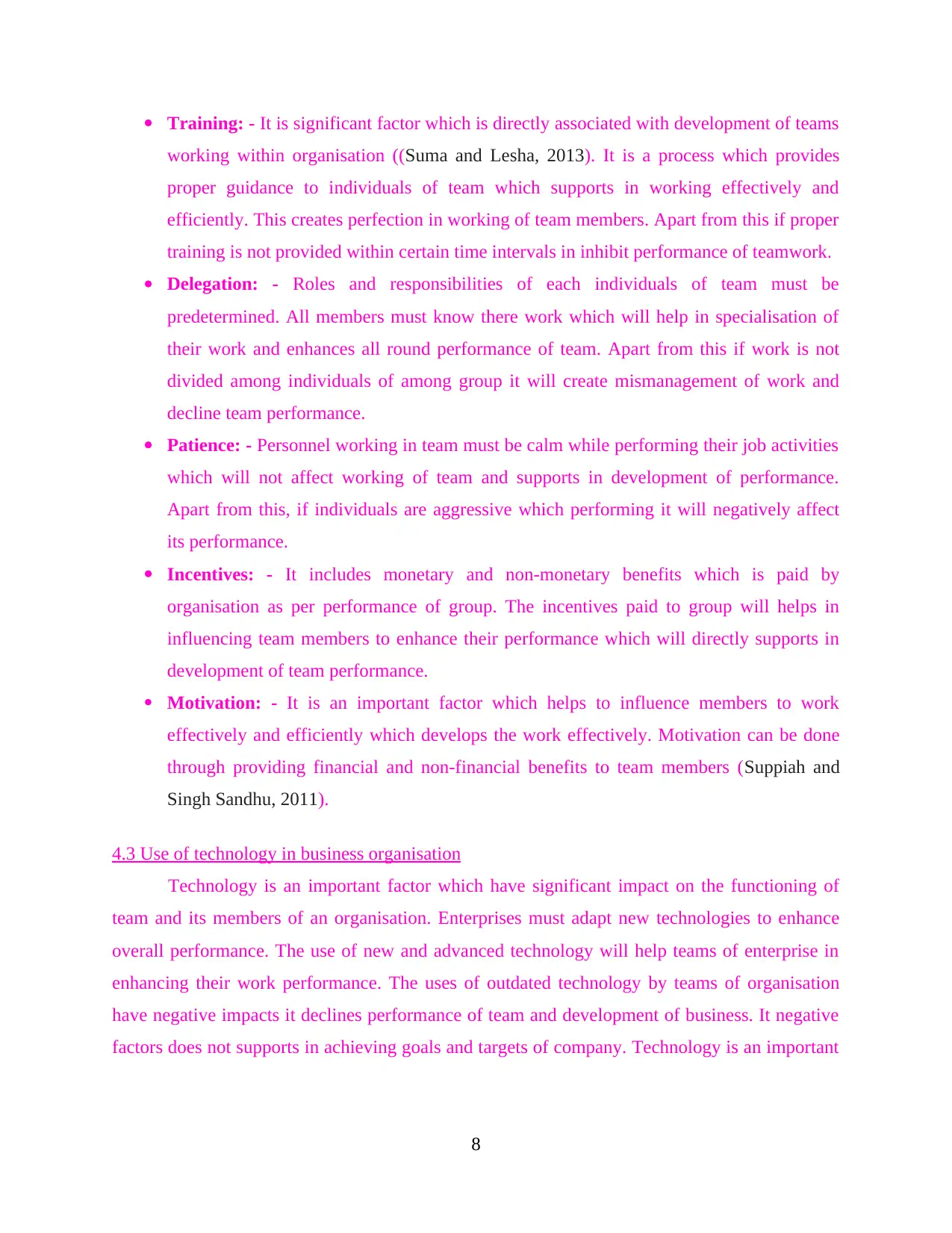
Training: - It is significant factor which is directly associated with development of teams
working within organisation ((Suma and Lesha, 2013). It is a process which provides
proper guidance to individuals of team which supports in working effectively and
efficiently. This creates perfection in working of team members. Apart from this if proper
training is not provided within certain time intervals in inhibit performance of teamwork.
Delegation: - Roles and responsibilities of each individuals of team must be
predetermined. All members must know there work which will help in specialisation of
their work and enhances all round performance of team. Apart from this if work is not
divided among individuals of among group it will create mismanagement of work and
decline team performance.
Patience: - Personnel working in team must be calm while performing their job activities
which will not affect working of team and supports in development of performance.
Apart from this, if individuals are aggressive which performing it will negatively affect
its performance.
Incentives: - It includes monetary and non-monetary benefits which is paid by
organisation as per performance of group. The incentives paid to group will helps in
influencing team members to enhance their performance which will directly supports in
development of team performance.
Motivation: - It is an important factor which helps to influence members to work
effectively and efficiently which develops the work effectively. Motivation can be done
through providing financial and non-financial benefits to team members (Suppiah and
Singh Sandhu, 2011).
4.3 Use of technology in business organisation
Technology is an important factor which have significant impact on the functioning of
team and its members of an organisation. Enterprises must adapt new technologies to enhance
overall performance. The use of new and advanced technology will help teams of enterprise in
enhancing their work performance. The uses of outdated technology by teams of organisation
have negative impacts it declines performance of team and development of business. It negative
factors does not supports in achieving goals and targets of company. Technology is an important
8
working within organisation ((Suma and Lesha, 2013). It is a process which provides
proper guidance to individuals of team which supports in working effectively and
efficiently. This creates perfection in working of team members. Apart from this if proper
training is not provided within certain time intervals in inhibit performance of teamwork.
Delegation: - Roles and responsibilities of each individuals of team must be
predetermined. All members must know there work which will help in specialisation of
their work and enhances all round performance of team. Apart from this if work is not
divided among individuals of among group it will create mismanagement of work and
decline team performance.
Patience: - Personnel working in team must be calm while performing their job activities
which will not affect working of team and supports in development of performance.
Apart from this, if individuals are aggressive which performing it will negatively affect
its performance.
Incentives: - It includes monetary and non-monetary benefits which is paid by
organisation as per performance of group. The incentives paid to group will helps in
influencing team members to enhance their performance which will directly supports in
development of team performance.
Motivation: - It is an important factor which helps to influence members to work
effectively and efficiently which develops the work effectively. Motivation can be done
through providing financial and non-financial benefits to team members (Suppiah and
Singh Sandhu, 2011).
4.3 Use of technology in business organisation
Technology is an important factor which have significant impact on the functioning of
team and its members of an organisation. Enterprises must adapt new technologies to enhance
overall performance. The use of new and advanced technology will help teams of enterprise in
enhancing their work performance. The uses of outdated technology by teams of organisation
have negative impacts it declines performance of team and development of business. It negative
factors does not supports in achieving goals and targets of company. Technology is an important
8
Paraphrase This Document
Need a fresh take? Get an instant paraphrase of this document with our AI Paraphraser
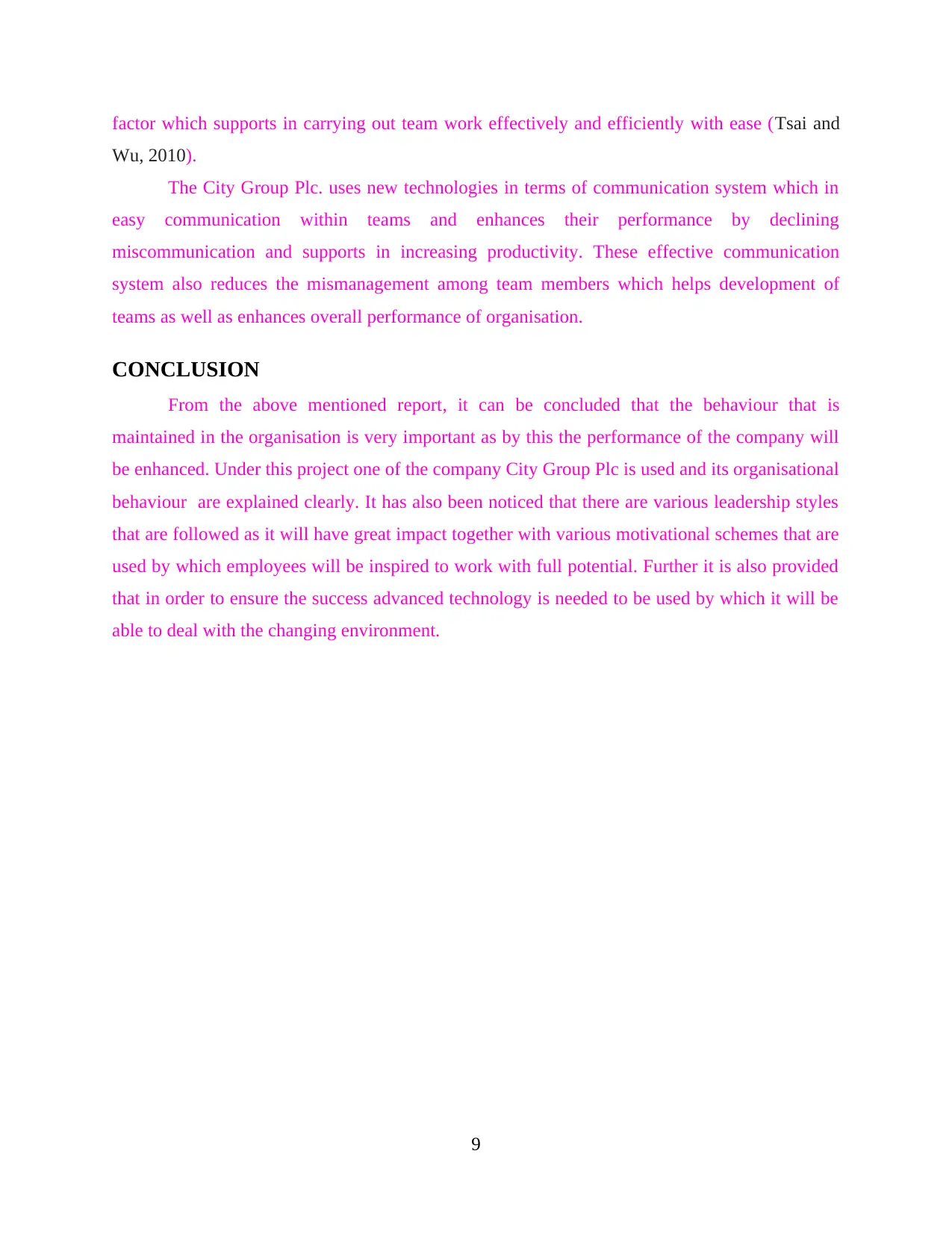
factor which supports in carrying out team work effectively and efficiently with ease (Tsai and
Wu, 2010).
The City Group Plc. uses new technologies in terms of communication system which in
easy communication within teams and enhances their performance by declining
miscommunication and supports in increasing productivity. These effective communication
system also reduces the mismanagement among team members which helps development of
teams as well as enhances overall performance of organisation.
CONCLUSION
From the above mentioned report, it can be concluded that the behaviour that is
maintained in the organisation is very important as by this the performance of the company will
be enhanced. Under this project one of the company City Group Plc is used and its organisational
behaviour are explained clearly. It has also been noticed that there are various leadership styles
that are followed as it will have great impact together with various motivational schemes that are
used by which employees will be inspired to work with full potential. Further it is also provided
that in order to ensure the success advanced technology is needed to be used by which it will be
able to deal with the changing environment.
9
Wu, 2010).
The City Group Plc. uses new technologies in terms of communication system which in
easy communication within teams and enhances their performance by declining
miscommunication and supports in increasing productivity. These effective communication
system also reduces the mismanagement among team members which helps development of
teams as well as enhances overall performance of organisation.
CONCLUSION
From the above mentioned report, it can be concluded that the behaviour that is
maintained in the organisation is very important as by this the performance of the company will
be enhanced. Under this project one of the company City Group Plc is used and its organisational
behaviour are explained clearly. It has also been noticed that there are various leadership styles
that are followed as it will have great impact together with various motivational schemes that are
used by which employees will be inspired to work with full potential. Further it is also provided
that in order to ensure the success advanced technology is needed to be used by which it will be
able to deal with the changing environment.
9
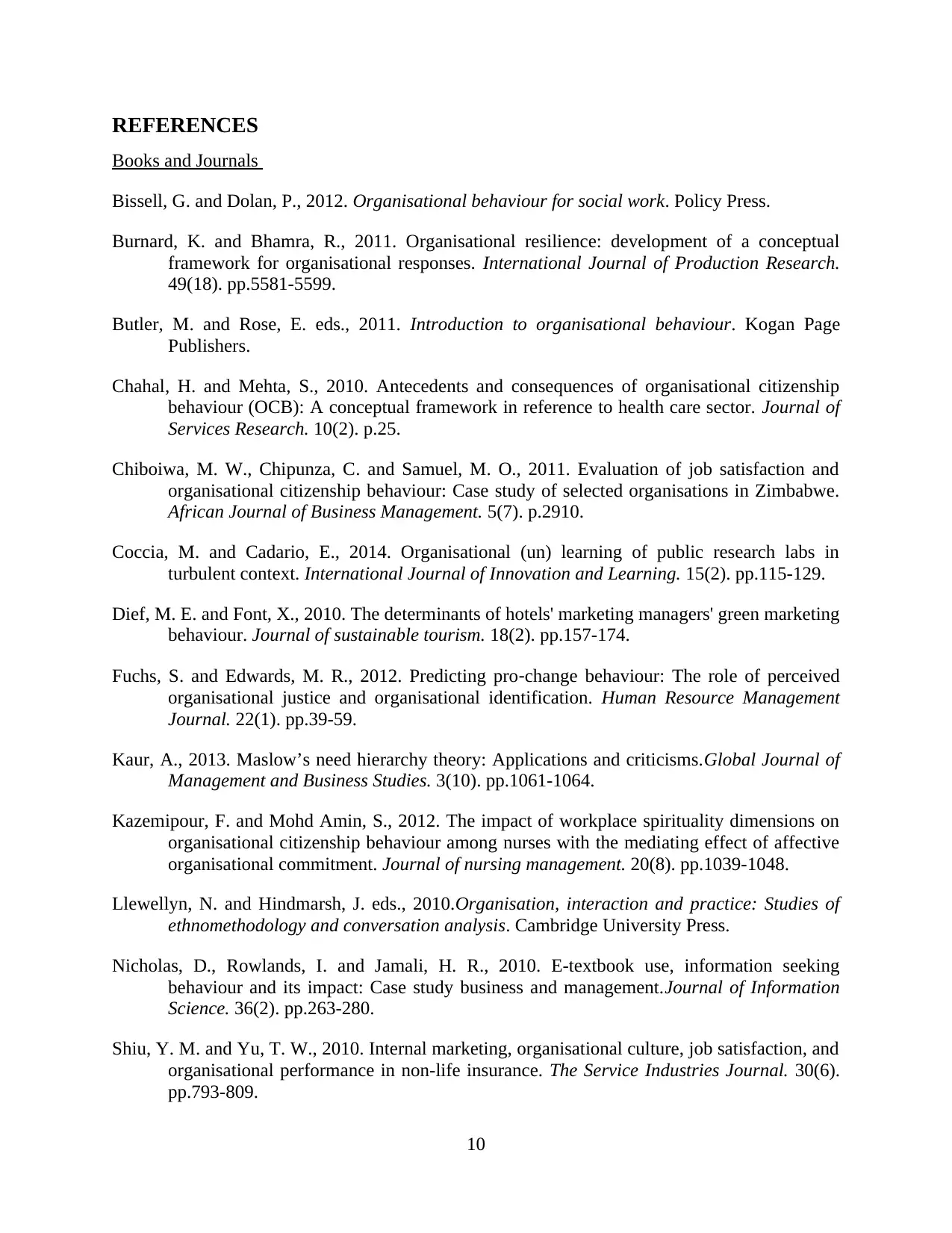
REFERENCES
Books and Journals
Bissell, G. and Dolan, P., 2012. Organisational behaviour for social work. Policy Press.
Burnard, K. and Bhamra, R., 2011. Organisational resilience: development of a conceptual
framework for organisational responses. International Journal of Production Research.
49(18). pp.5581-5599.
Butler, M. and Rose, E. eds., 2011. Introduction to organisational behaviour. Kogan Page
Publishers.
Chahal, H. and Mehta, S., 2010. Antecedents and consequences of organisational citizenship
behaviour (OCB): A conceptual framework in reference to health care sector. Journal of
Services Research. 10(2). p.25.
Chiboiwa, M. W., Chipunza, C. and Samuel, M. O., 2011. Evaluation of job satisfaction and
organisational citizenship behaviour: Case study of selected organisations in Zimbabwe.
African Journal of Business Management. 5(7). p.2910.
Coccia, M. and Cadario, E., 2014. Organisational (un) learning of public research labs in
turbulent context. International Journal of Innovation and Learning. 15(2). pp.115-129.
Dief, M. E. and Font, X., 2010. The determinants of hotels' marketing managers' green marketing
behaviour. Journal of sustainable tourism. 18(2). pp.157-174.
Fuchs, S. and Edwards, M. R., 2012. Predicting pro‐change behaviour: The role of perceived
organisational justice and organisational identification. Human Resource Management
Journal. 22(1). pp.39-59.
Kaur, A., 2013. Maslow’s need hierarchy theory: Applications and criticisms.Global Journal of
Management and Business Studies. 3(10). pp.1061-1064.
Kazemipour, F. and Mohd Amin, S., 2012. The impact of workplace spirituality dimensions on
organisational citizenship behaviour among nurses with the mediating effect of affective
organisational commitment. Journal of nursing management. 20(8). pp.1039-1048.
Llewellyn, N. and Hindmarsh, J. eds., 2010.Organisation, interaction and practice: Studies of
ethnomethodology and conversation analysis. Cambridge University Press.
Nicholas, D., Rowlands, I. and Jamali, H. R., 2010. E-textbook use, information seeking
behaviour and its impact: Case study business and management.Journal of Information
Science. 36(2). pp.263-280.
Shiu, Y. M. and Yu, T. W., 2010. Internal marketing, organisational culture, job satisfaction, and
organisational performance in non-life insurance. The Service Industries Journal. 30(6).
pp.793-809.
10
Books and Journals
Bissell, G. and Dolan, P., 2012. Organisational behaviour for social work. Policy Press.
Burnard, K. and Bhamra, R., 2011. Organisational resilience: development of a conceptual
framework for organisational responses. International Journal of Production Research.
49(18). pp.5581-5599.
Butler, M. and Rose, E. eds., 2011. Introduction to organisational behaviour. Kogan Page
Publishers.
Chahal, H. and Mehta, S., 2010. Antecedents and consequences of organisational citizenship
behaviour (OCB): A conceptual framework in reference to health care sector. Journal of
Services Research. 10(2). p.25.
Chiboiwa, M. W., Chipunza, C. and Samuel, M. O., 2011. Evaluation of job satisfaction and
organisational citizenship behaviour: Case study of selected organisations in Zimbabwe.
African Journal of Business Management. 5(7). p.2910.
Coccia, M. and Cadario, E., 2014. Organisational (un) learning of public research labs in
turbulent context. International Journal of Innovation and Learning. 15(2). pp.115-129.
Dief, M. E. and Font, X., 2010. The determinants of hotels' marketing managers' green marketing
behaviour. Journal of sustainable tourism. 18(2). pp.157-174.
Fuchs, S. and Edwards, M. R., 2012. Predicting pro‐change behaviour: The role of perceived
organisational justice and organisational identification. Human Resource Management
Journal. 22(1). pp.39-59.
Kaur, A., 2013. Maslow’s need hierarchy theory: Applications and criticisms.Global Journal of
Management and Business Studies. 3(10). pp.1061-1064.
Kazemipour, F. and Mohd Amin, S., 2012. The impact of workplace spirituality dimensions on
organisational citizenship behaviour among nurses with the mediating effect of affective
organisational commitment. Journal of nursing management. 20(8). pp.1039-1048.
Llewellyn, N. and Hindmarsh, J. eds., 2010.Organisation, interaction and practice: Studies of
ethnomethodology and conversation analysis. Cambridge University Press.
Nicholas, D., Rowlands, I. and Jamali, H. R., 2010. E-textbook use, information seeking
behaviour and its impact: Case study business and management.Journal of Information
Science. 36(2). pp.263-280.
Shiu, Y. M. and Yu, T. W., 2010. Internal marketing, organisational culture, job satisfaction, and
organisational performance in non-life insurance. The Service Industries Journal. 30(6).
pp.793-809.
10
⊘ This is a preview!⊘
Do you want full access?
Subscribe today to unlock all pages.

Trusted by 1+ million students worldwide
1 out of 13
Related Documents
Your All-in-One AI-Powered Toolkit for Academic Success.
+13062052269
info@desklib.com
Available 24*7 on WhatsApp / Email
![[object Object]](/_next/static/media/star-bottom.7253800d.svg)
Unlock your academic potential
Copyright © 2020–2025 A2Z Services. All Rights Reserved. Developed and managed by ZUCOL.





